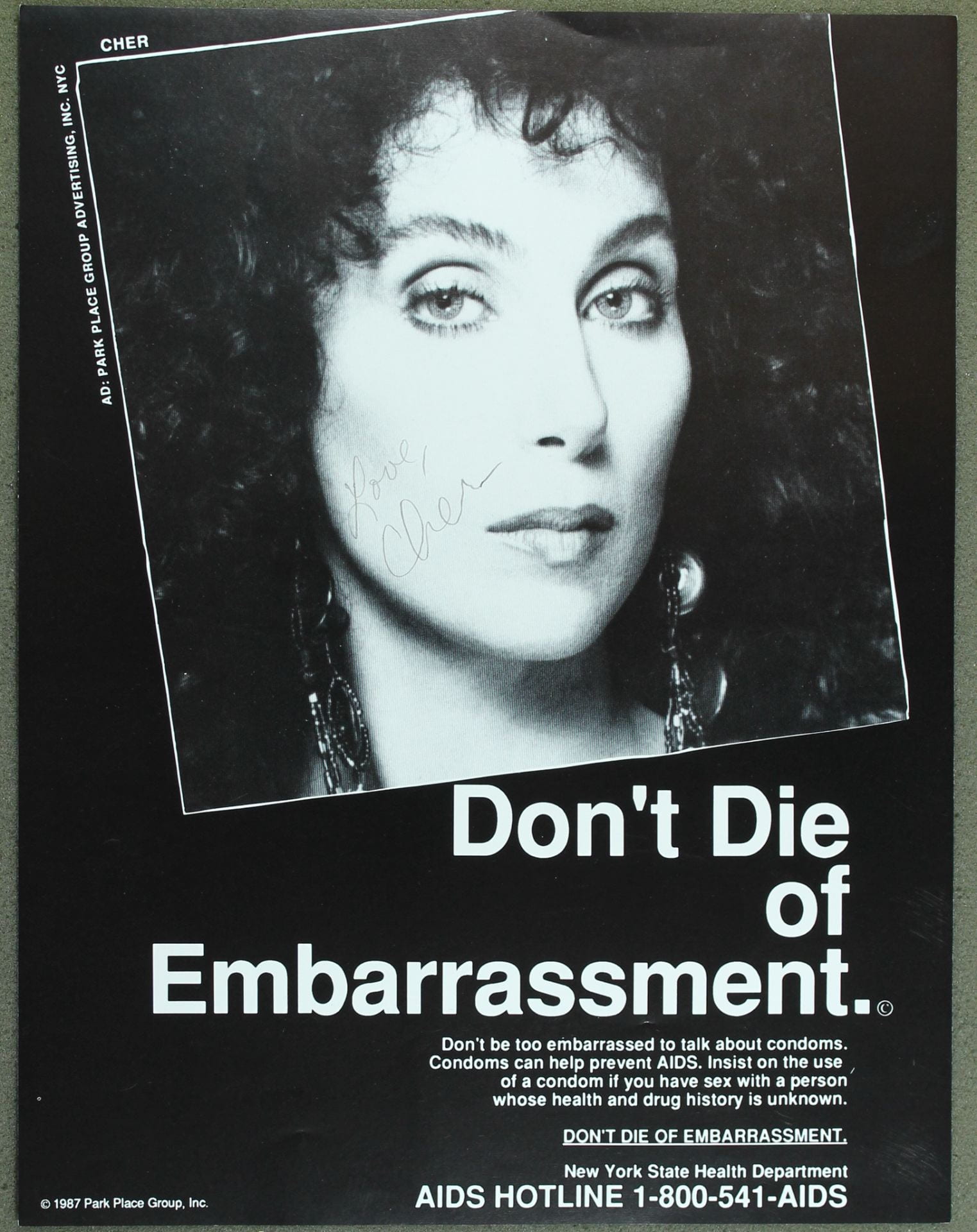Celebrity Capital and Public Health Campaigns
Claudia León, Class of 2023, American Studies & Latino Studies/History
 In 1987, the New York State Health Department released these posters as part of a larger campaign titled “AIDS Does Not Discriminate,” a response to the stigma affecting those infected with, and at risk for, HIV/AIDS. These posters were one part; other components included radio/television advertisements, transit advertisements, paycheck inserts, and, most importantly, the AIDS Hotline. Preexisting homophobic, racist, and classist stereotypes, and the perception of AIDS as an individual issue, rather than a public health crisis, were both incorrect and deadly— over 25,000 people died of complications before President Reagan even publicly said the word “AIDS”. Large-scale educational campaigns sought to combat this stigma, reframing it as a question of taking care of your health rather than focusing on the moral failings contemporarily associated with diagnosis.
In 1987, the New York State Health Department released these posters as part of a larger campaign titled “AIDS Does Not Discriminate,” a response to the stigma affecting those infected with, and at risk for, HIV/AIDS. These posters were one part; other components included radio/television advertisements, transit advertisements, paycheck inserts, and, most importantly, the AIDS Hotline. Preexisting homophobic, racist, and classist stereotypes, and the perception of AIDS as an individual issue, rather than a public health crisis, were both incorrect and deadly— over 25,000 people died of complications before President Reagan even publicly said the word “AIDS”. Large-scale educational campaigns sought to combat this stigma, reframing it as a question of taking care of your health rather than focusing on the moral failings contemporarily associated with diagnosis.
 The influx of campaigns aiming to destigmatize risk-preventing behavior — here, condom usage— coincided with a broader understanding of AIDS as a nondiscriminatory virus. Particularly, as the number of afflicted heterosexuals began to rise, scientists started accepting that more than sexual orientation or race, it was certain behaviors that increased one’s risk of contracting the virus. Public health campaigns adapted in kind, targeting the straight community through the use of heterosexual public figures like singer Cher (gay icon may she be, since at this point she was mainly known for her starring role alongside Nicolas Cage in the 1987 rom-com Moonstruck) and actor Esai Morales. These campaigns took advantage of celebrity power and capitalized on the recent trend towards fear-based public health initiatives popularized by anti-tobacco campaigns; as Fairchild et al. discuss in their article on AIDS public health campaigns, the fear-based warning is combined with information and resources that could correct misperceptions.
The influx of campaigns aiming to destigmatize risk-preventing behavior — here, condom usage— coincided with a broader understanding of AIDS as a nondiscriminatory virus. Particularly, as the number of afflicted heterosexuals began to rise, scientists started accepting that more than sexual orientation or race, it was certain behaviors that increased one’s risk of contracting the virus. Public health campaigns adapted in kind, targeting the straight community through the use of heterosexual public figures like singer Cher (gay icon may she be, since at this point she was mainly known for her starring role alongside Nicolas Cage in the 1987 rom-com Moonstruck) and actor Esai Morales. These campaigns took advantage of celebrity power and capitalized on the recent trend towards fear-based public health initiatives popularized by anti-tobacco campaigns; as Fairchild et al. discuss in their article on AIDS public health campaigns, the fear-based warning is combined with information and resources that could correct misperceptions.
Source
Cher and Esai Morales AIDS Hotline Promotional Posters, New York State Department of Health, c. 1987. Sexuality in society ephemera, 1960-2015, Box 1 Folder 4, Division of Rare and Manuscript Collections, Cornell University Library, ID#7323.
https://rmc.library.cornell.edu/EAD/htmldocs/RMM07323.html
Bibliography
Amy Lauren Fairchild et al., “The Two Faces of Fear: A History of Hard-Hitting Public Health Campaigns Against Tobacco and AIDS,” American Journal of Public Health, September 2018, https://www.ncbi.nlm.nih.gov/pmc/articles/PMC6085018/.
Julia Davis, “Evolution of an Epidemic: 25 Years of HIV/AIDS Media Campaigns in the U.S.,” June 2006, https://www.kff.org/wp-content/uploads/2013/01/7515.pdf.
Michael Stone, “A Q and A on AIDS,” New York Magazine, March 1987, https://books.google.com/books?id=c-QCAAAAMBAJ&pg=PA35&dq=heterosexuals+and+aids&hl=en&sa=X&ved=2ahUKEwiup7X2gcnzAhWJrHIEHTOsABkQ6AF6BAgDEAI#v=onepage&q=heterosexuals%20and%20aids&f=false.
New York State Department of Health, AIDS Institute, “AIDS Institute: 25 Years,” New York State Department of Health, May 2010, https://www.health.ny.gov/diseases/aids/providers/reports/docs/aids_institute_25-years.pdf.
“Reagan’s AIDSGATE,” ACT UP New York, 1987, https://actupny.org/reports/reagan.html.
“The HIV/AIDS Epidemic in the United States: The Basics,” Kaiser Family Foundation, June 7, 2021, https://www.kff.org/hivaids/fact-sheet/the-hivaids-epidemic-in-the-united-states-the-basics/.

